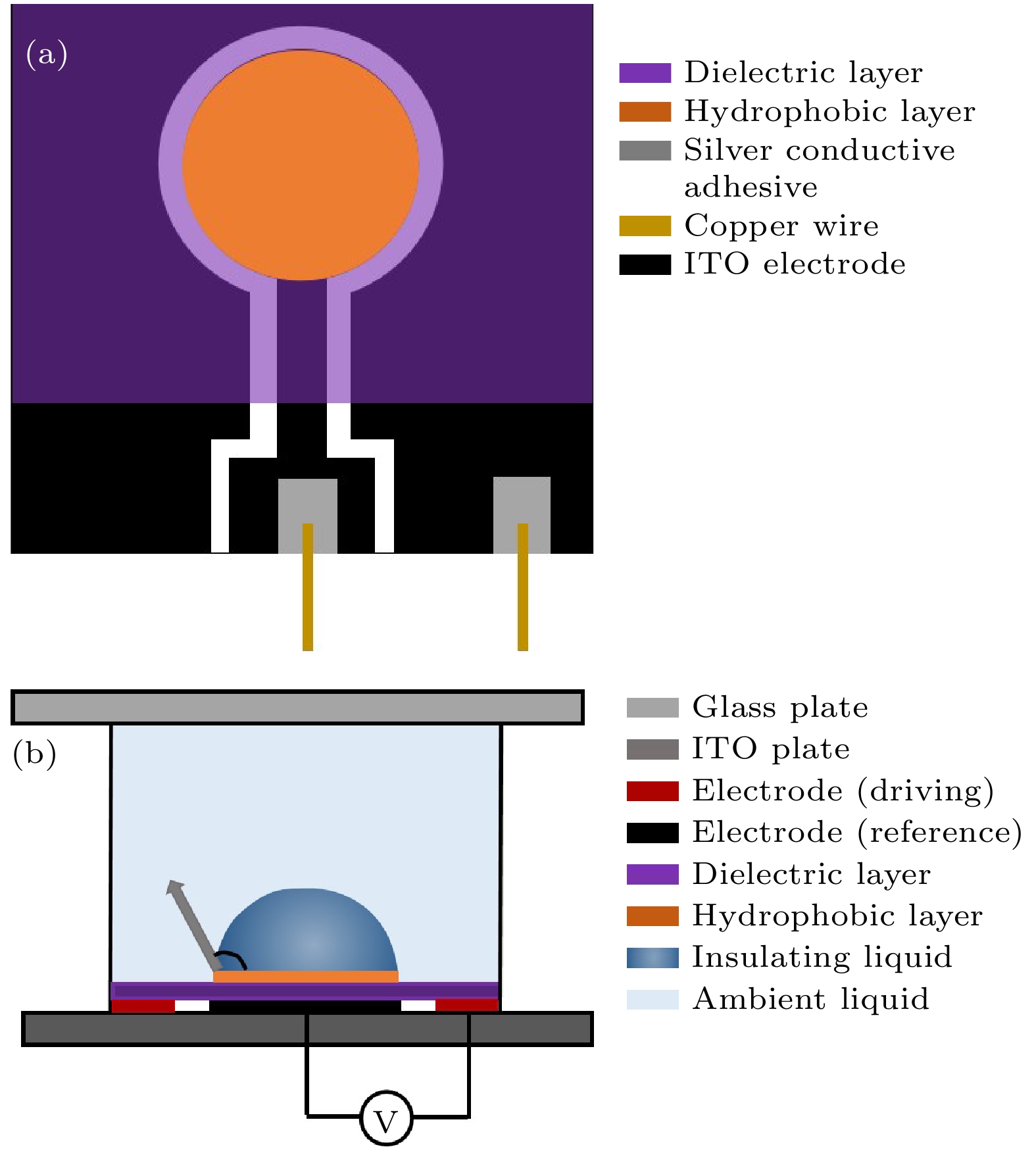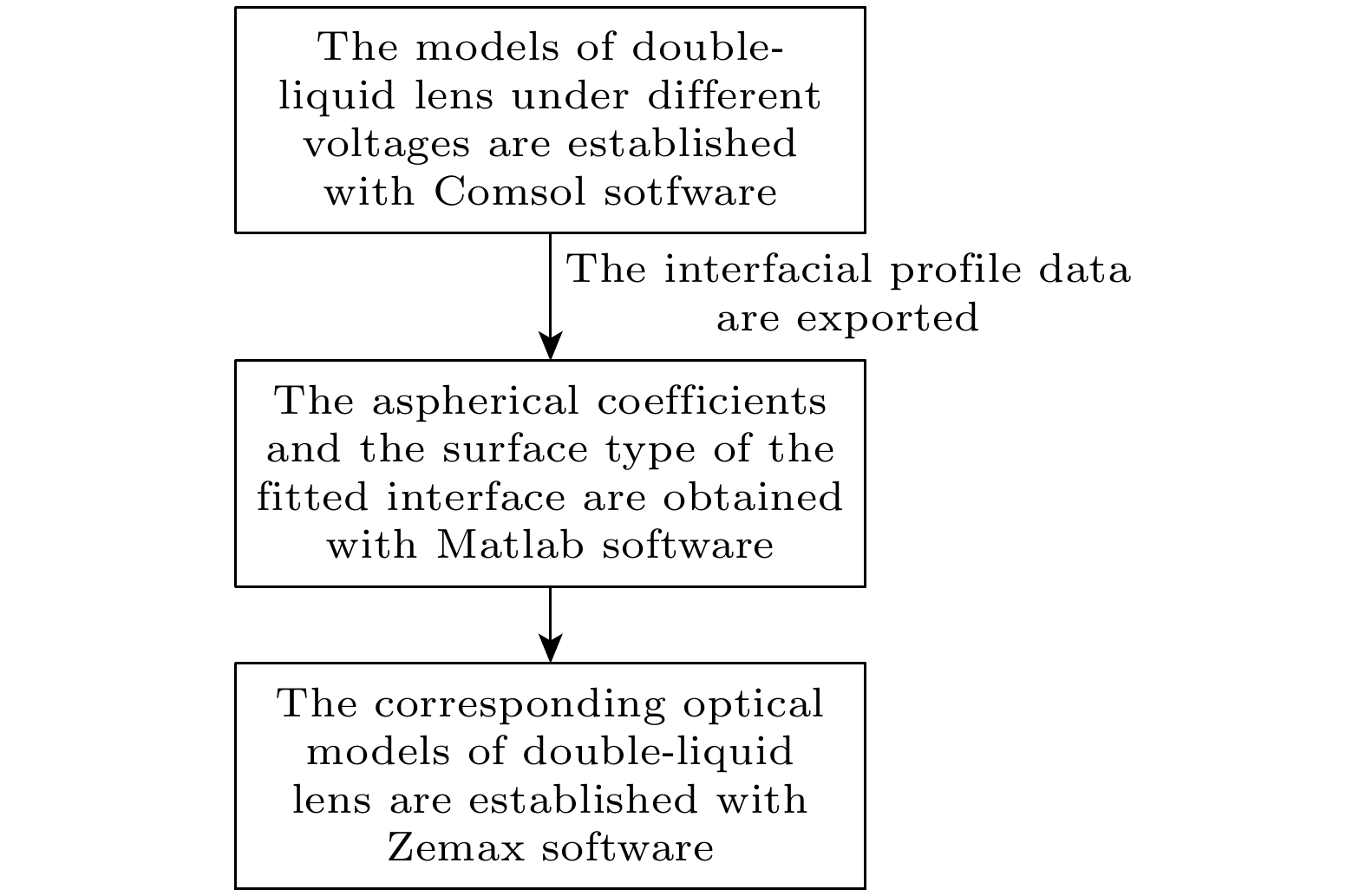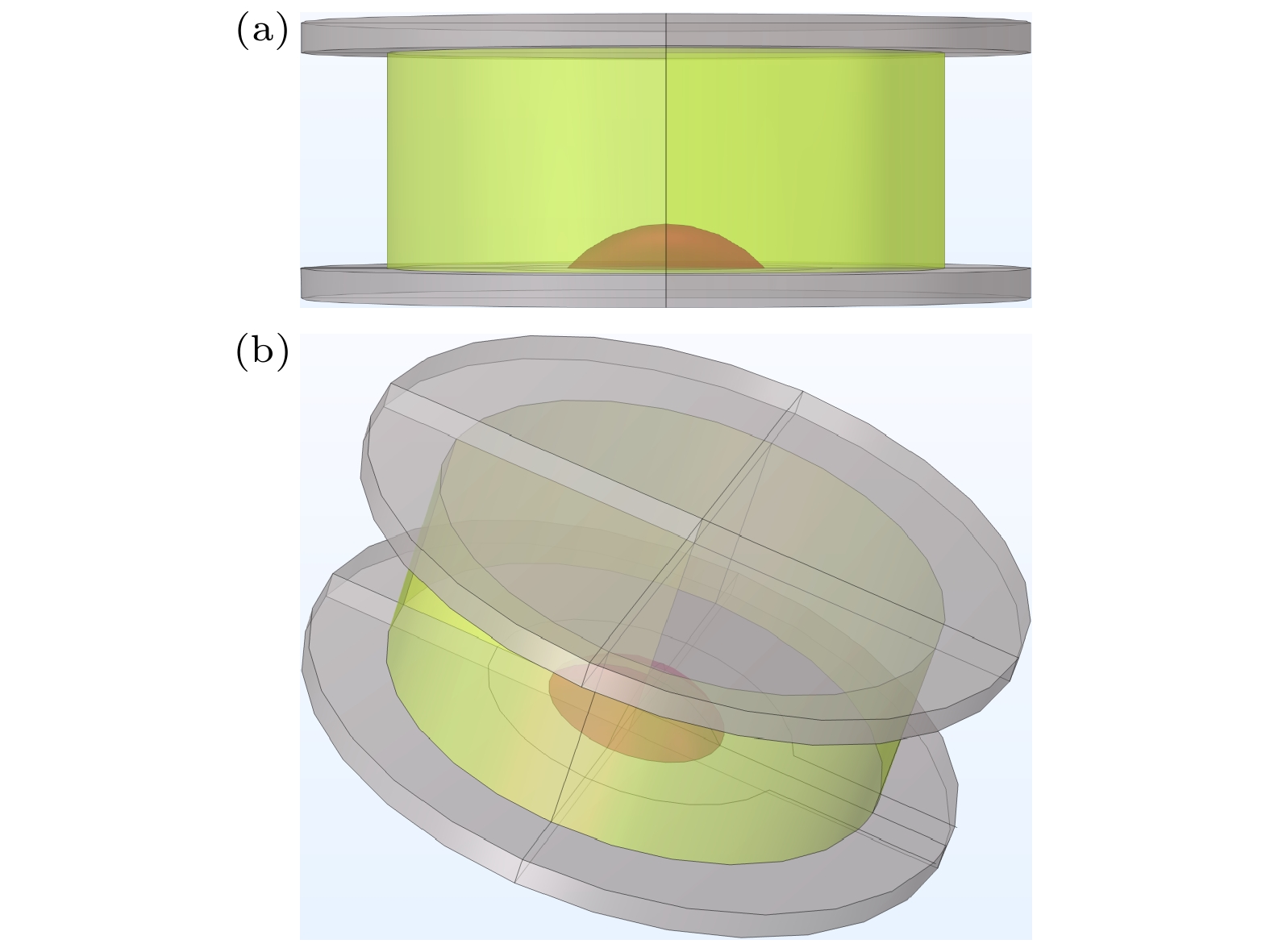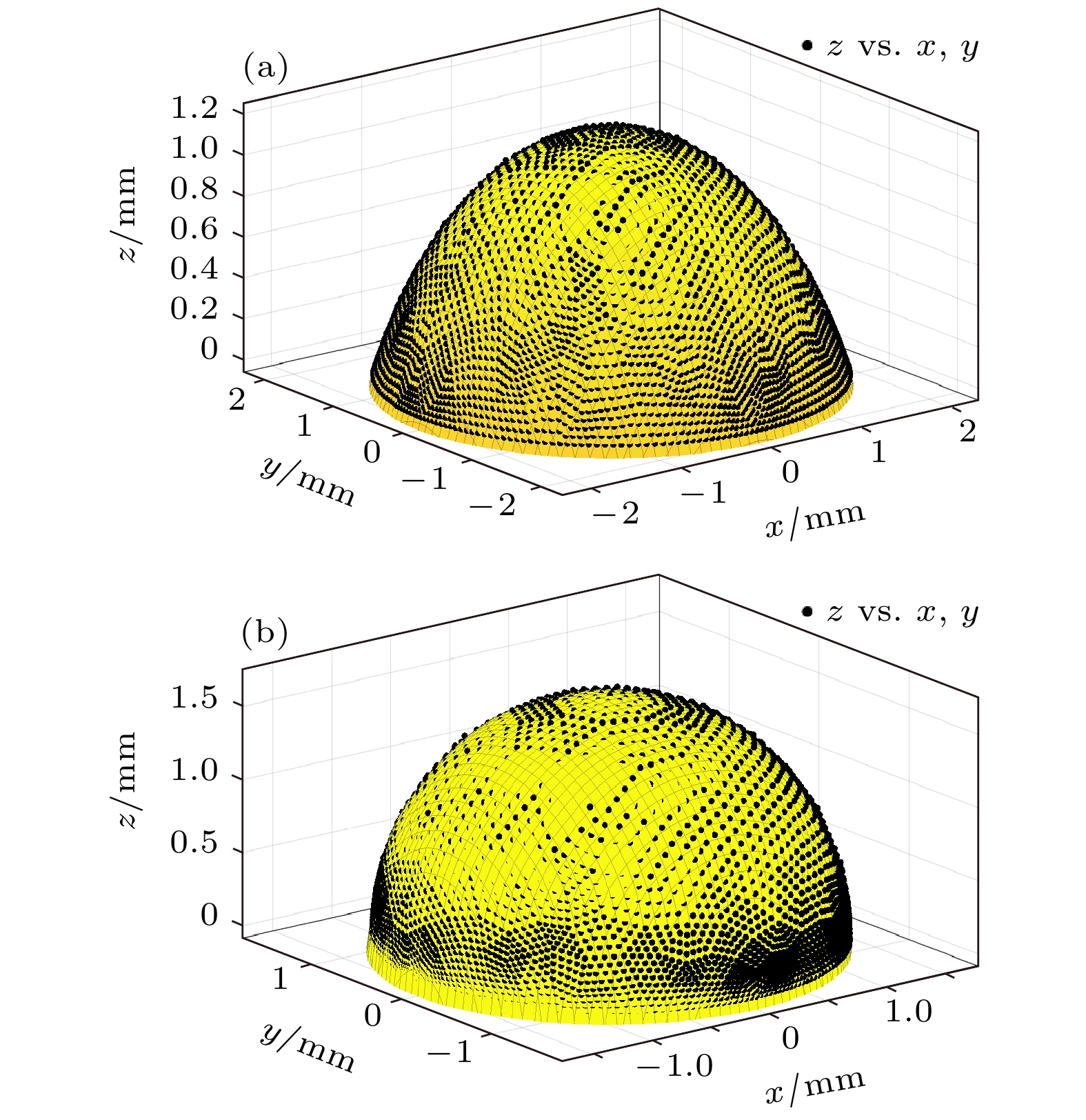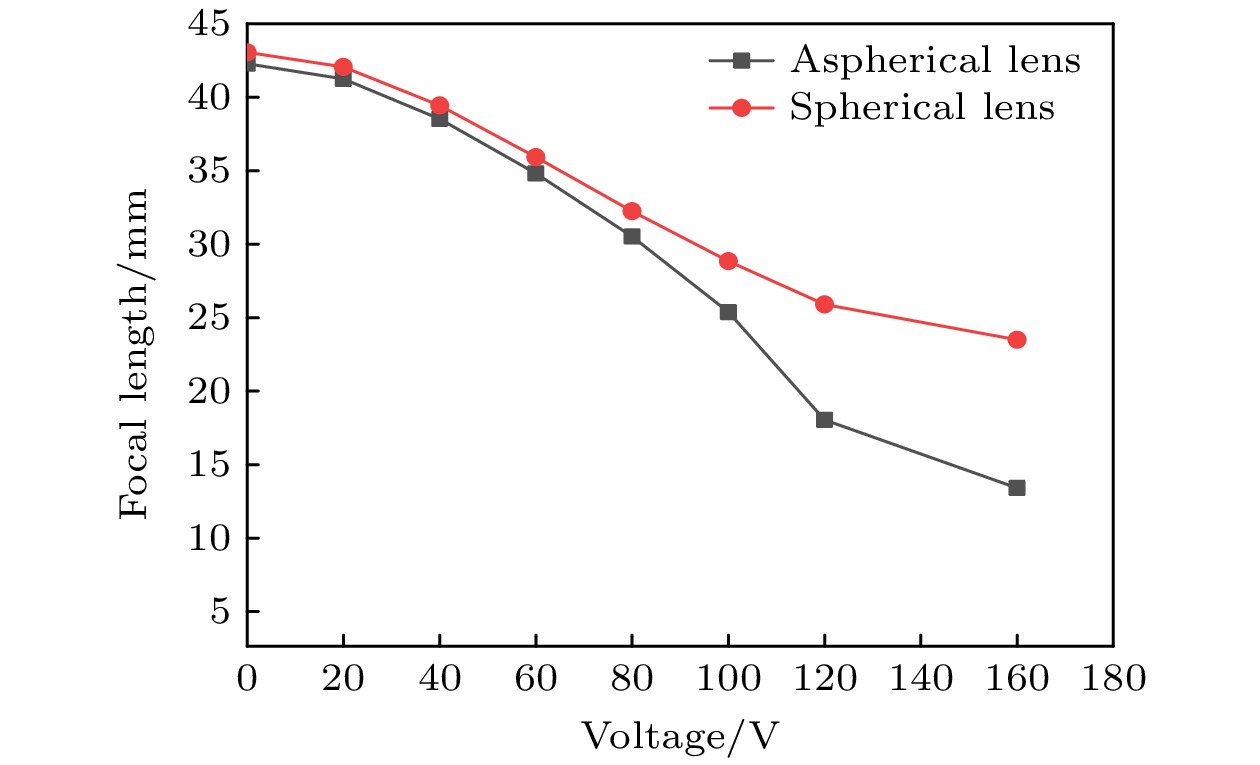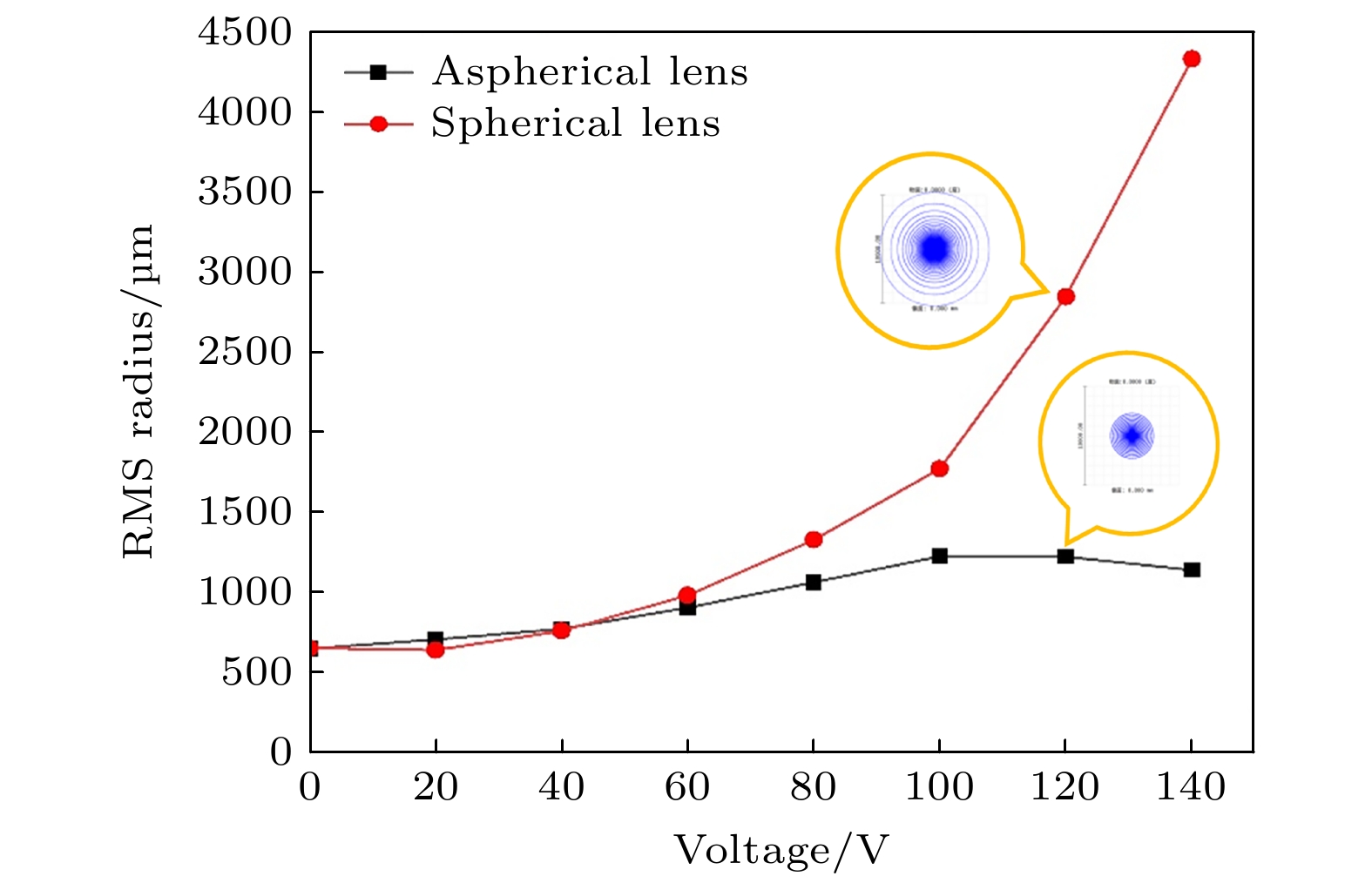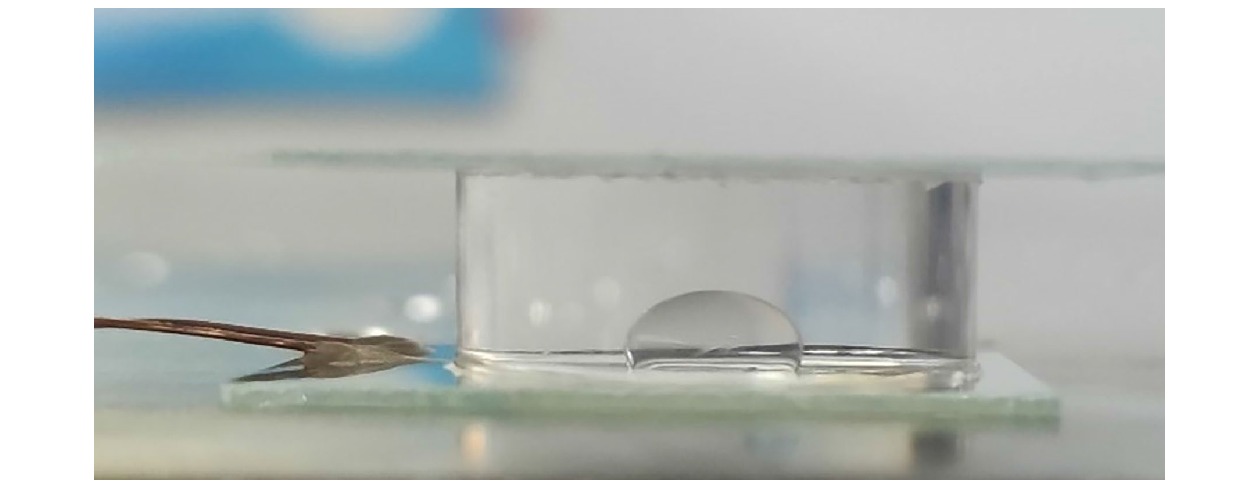-
In order to study an aspherical liquid lens with simple structure and easy realization, an aspherical double-liquid lens based on planar electrode is designed based on the dielectrophoretic effect. The droplet in the dielectric electrophoretic liquid lens is polarized in the electric field and moves towards the higher electric field strength under the action of the dielectrophoresis force. With the change of the applied voltage, the dielectrophoresis force also changes, thus the contact angle of the droplet at the solid-liquid interface changes. Firstly, the models of the aspherical double-liquid lens under different voltages are established with Comsol software, and the interfacial profile data are obtained. Then the aspherical coefficients and the surface type of the fitted interface are obtained with Matlab software. Finally, the corresponding optical model of double-liquid lens is established with Zemax software. The variable range of focal lengths and root mean square (RMS) radii of the aspherical double-liquid lens at different voltages are obtained. In order to further study the characteristics of the aspherical double-liquid lens, it is compared with a spherical double-liquid lens model. Based on the contact angle theory of liquid lens and Gaussian optics theory, the relationship between the interfacial curvature radius of the spherical liquid lens and the applied voltage, and the relationship between the focal length and the applied voltage are obtained, respectively. The liquid material, cavity structure and droplet are the same as those of the aspherical lens. The corresponding spherical double-liquid lens model is established according to the two expressions relating to Zemax, and the voltage value is the same as that of the aspherical lens. Thus, the variable ranges of focal length and RMS radius in the spot diagram of the spherical double-liquid lenses at different voltages are obtained. Then, they are compared with those of aspherical double-liquid lens, and the results show that the variable range of focal length of the aspherical double-liquid lens is larger than that of the spherical double-liquid lens, and the imaging quality of the former is better than that of the latter. Moreover, through the device fabrication and preliminary experimental analysis of the aspherical double-liquid lens, the imaging resolution can reach 40.318 lp/mm. The aspherical double-liquid lens proposed in this work has the characteristics of simple structure and easy realization, which can provide a new scheme for high-quality imaging of liquid lens and its applications, and can expand the application scope of liquid lens.
-
Keywords:
- liquid lens /
- aspherical surface /
- planar electrode /
- dielectrophoretic effect
[1] Kuiper S, Hendriks B H W 2004 Appl. Phys. Lett. 85 1128
 Google Scholar
Google Scholar
[2] Kuiper S 2011 Electrowetting-based Liquid Lenses for Endoscopy (San Francisco: SPIE) p47
[3] Zhang F M, Yao Y N, Qu X H, Zhang T 2017 Opt. Laser. Technol. 88 198
 Google Scholar
Google Scholar
[4] Ma H G, Cheng Z W, Wang Z Y, Xiong K D, Yang S H 2019 Opt. Lett. 44 1880
 Google Scholar
Google Scholar
[5] Cao Z L, Cheng C, Wang K Y 2014 7th International Symposium on Advanced Optical Manufacturing and Testing Technologies: Advanced Optical Manufacturing Technologies Harbin, China, August 6, 2014 p111
[6] Mishra K, Murade C, Carreel B, Roghair I, Oh J M, Manukyan G, Dirk V D E, Mugele F 2014 Sci. Rep. 4 6378
 Google Scholar
Google Scholar
[7] Mishra K, Mugele F 2016 Opt. Express 24 14672
 Google Scholar
Google Scholar
[8] Lima N C, Mishra K, Mugele F 2017 Opt. Express 25 6700
 Google Scholar
Google Scholar
[9] Mishra K, Narayanan A, Mugele F 2019 Opt. Express 27 17601
 Google Scholar
Google Scholar
[10] Zhao P P, Ataman Ç, Zappe H 2016 IEEE 29th International Conference on Micro Electro Mechanical Systems (MEMS) Shang hai, China, January 24–28, 2016 p609
[11] Zhao P P, Ataman Ç, Zappe H 2016 Appl. Optics 55 7816
 Google Scholar
Google Scholar
[12] Zhao P P, Ataman Ç, Zappe H 2017 Opt. Eng. 56 103110
 Google Scholar
Google Scholar
[13] Strauch M, Somers P A A M, Bociort F, Urbach H P 2018 AIP. Adv. 8 115224
 Google Scholar
Google Scholar
[14] Wang J H, Zhou X, Luo L, Yuan R Y, Wang Q H 2019 Opt. Commun. 445 56
 Google Scholar
Google Scholar
[15] Kong M M, Zhu L F, Chen D, Liang Z C, Zhao R, Xu E M 2016 J. Opt. Soc. Korea 20 427
 Google Scholar
Google Scholar
[16] Kong M M, Chen X, Yuan Y, Zhao R, Chen T, Liang Z C 2019 Curr. Opt. Photonics 3 177
 Google Scholar
Google Scholar
[17] Wu S T, Ren H 2012 Introduction to Adaptive Lenses (Hoboken: Willey) pp108–148
[18] 王琼华, 刘超, 王迪, 李磊 2021 液体光子器件 (北京: 科学出版社) 第37页
Wang Q H, Liu C, Wang D, Li L 2021 Liquid Photonic Device (Beijing: Science Press) p37 (in Chinese)
[19] 孔梅梅, 潘世成, 袁东, 孙小波, 薛银燕, 赵瑞, 陈陶 2023 激光与光电子学进展 60 192202
Kong M M, Pan S C, Yuan D, Sun X B, Xue Y Y, Zhao R, Chen T 2023 Laser. Optoelectron. Progr. 60 192202
[20] 张以谟 1982 应用光学 (北京: 机械工业出版社) 第30页
Zhang Y M 1982 Applied Optics (Beijing: China Machine Press) p30 (in Chinese)
[21] Xu M, Liu Y T, Yuan Y, Lu H B, Qiu L Z 2022 Opt. Lett. 47 509
 Google Scholar
Google Scholar
-
-
[1] Kuiper S, Hendriks B H W 2004 Appl. Phys. Lett. 85 1128
 Google Scholar
Google Scholar
[2] Kuiper S 2011 Electrowetting-based Liquid Lenses for Endoscopy (San Francisco: SPIE) p47
[3] Zhang F M, Yao Y N, Qu X H, Zhang T 2017 Opt. Laser. Technol. 88 198
 Google Scholar
Google Scholar
[4] Ma H G, Cheng Z W, Wang Z Y, Xiong K D, Yang S H 2019 Opt. Lett. 44 1880
 Google Scholar
Google Scholar
[5] Cao Z L, Cheng C, Wang K Y 2014 7th International Symposium on Advanced Optical Manufacturing and Testing Technologies: Advanced Optical Manufacturing Technologies Harbin, China, August 6, 2014 p111
[6] Mishra K, Murade C, Carreel B, Roghair I, Oh J M, Manukyan G, Dirk V D E, Mugele F 2014 Sci. Rep. 4 6378
 Google Scholar
Google Scholar
[7] Mishra K, Mugele F 2016 Opt. Express 24 14672
 Google Scholar
Google Scholar
[8] Lima N C, Mishra K, Mugele F 2017 Opt. Express 25 6700
 Google Scholar
Google Scholar
[9] Mishra K, Narayanan A, Mugele F 2019 Opt. Express 27 17601
 Google Scholar
Google Scholar
[10] Zhao P P, Ataman Ç, Zappe H 2016 IEEE 29th International Conference on Micro Electro Mechanical Systems (MEMS) Shang hai, China, January 24–28, 2016 p609
[11] Zhao P P, Ataman Ç, Zappe H 2016 Appl. Optics 55 7816
 Google Scholar
Google Scholar
[12] Zhao P P, Ataman Ç, Zappe H 2017 Opt. Eng. 56 103110
 Google Scholar
Google Scholar
[13] Strauch M, Somers P A A M, Bociort F, Urbach H P 2018 AIP. Adv. 8 115224
 Google Scholar
Google Scholar
[14] Wang J H, Zhou X, Luo L, Yuan R Y, Wang Q H 2019 Opt. Commun. 445 56
 Google Scholar
Google Scholar
[15] Kong M M, Zhu L F, Chen D, Liang Z C, Zhao R, Xu E M 2016 J. Opt. Soc. Korea 20 427
 Google Scholar
Google Scholar
[16] Kong M M, Chen X, Yuan Y, Zhao R, Chen T, Liang Z C 2019 Curr. Opt. Photonics 3 177
 Google Scholar
Google Scholar
[17] Wu S T, Ren H 2012 Introduction to Adaptive Lenses (Hoboken: Willey) pp108–148
[18] 王琼华, 刘超, 王迪, 李磊 2021 液体光子器件 (北京: 科学出版社) 第37页
Wang Q H, Liu C, Wang D, Li L 2021 Liquid Photonic Device (Beijing: Science Press) p37 (in Chinese)
[19] 孔梅梅, 潘世成, 袁东, 孙小波, 薛银燕, 赵瑞, 陈陶 2023 激光与光电子学进展 60 192202
Kong M M, Pan S C, Yuan D, Sun X B, Xue Y Y, Zhao R, Chen T 2023 Laser. Optoelectron. Progr. 60 192202
[20] 张以谟 1982 应用光学 (北京: 机械工业出版社) 第30页
Zhang Y M 1982 Applied Optics (Beijing: China Machine Press) p30 (in Chinese)
[21] Xu M, Liu Y T, Yuan Y, Lu H B, Qiu L Z 2022 Opt. Lett. 47 509
 Google Scholar
Google Scholar
Catalog
Metrics
- Abstract views: 4859
- PDF Downloads: 88
- Cited By: 0














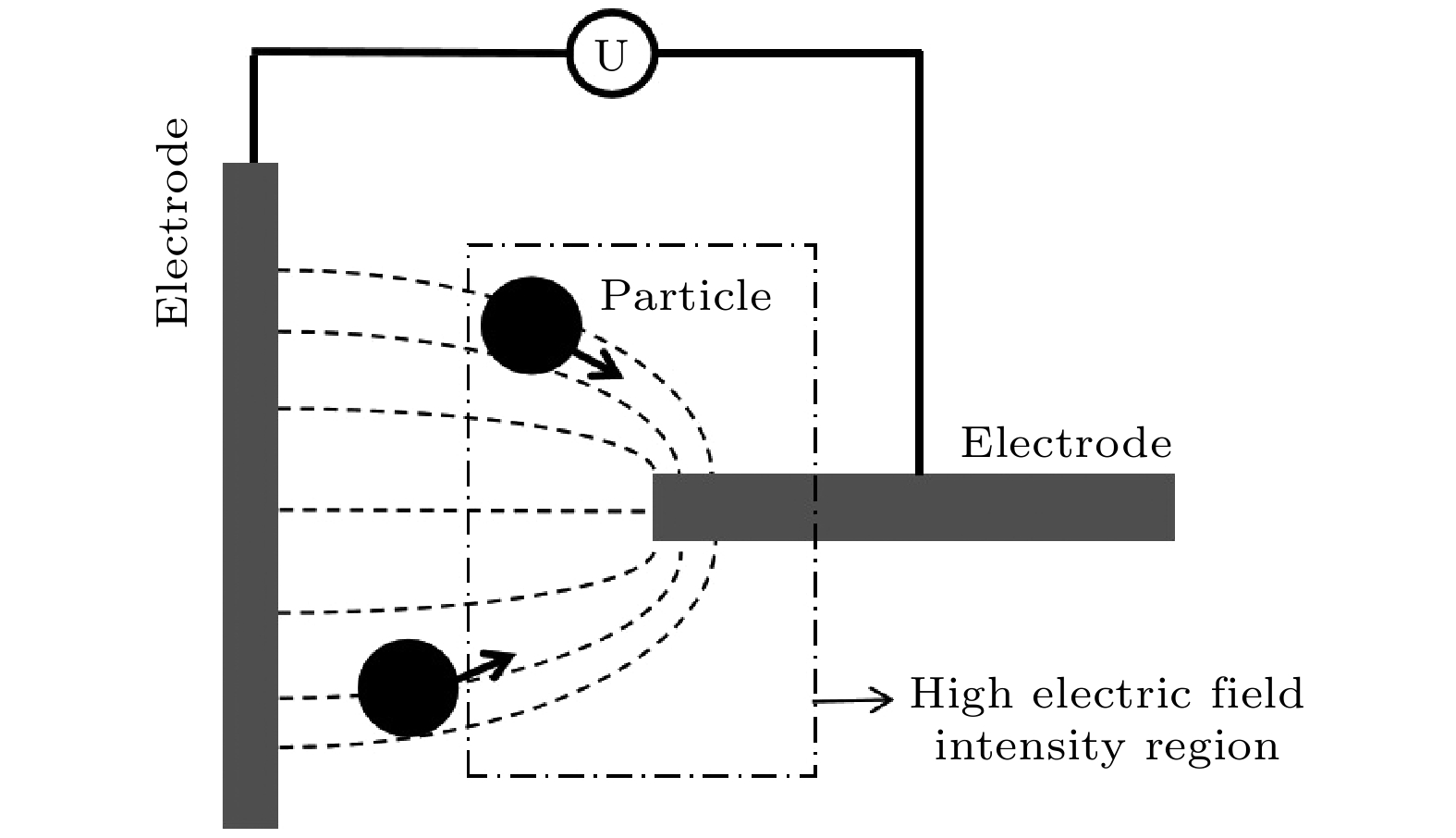
 DownLoad:
DownLoad:
